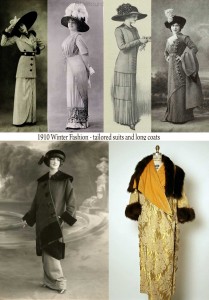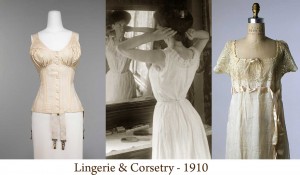A 1910 Review of the complete wardrobe for the fashionable woman for Autumn and Winter –
Originally published by the Salt Lake Tribune – Sunday Sept 11th 1910.
The Fashion Dictates in Suits and Gowns – by Joan Greenshields.
The cult of the tailor made suit has increased by leaps and bounds this past few seasons. There is nothing more suited to our climate than the cloth and coat skirt. In America, we women have combined to perfection – the mannish English line and the softly feminine French line to produce a pleasing curved silhouette for the coming dress fashions of 1911. As for the textiles – Irish, Scots and English homespun, tweed mixtures from Paris,and lush velvets – all vie for first place. Dark shades predominate!
The 1910 Ladies Coat Style.
The long coat now has a distinct place in any lady’s wardrobe. As to the style – the close silhouette is adhered to very distinctly. Skillful goring and in some cases a seam directly over each hip is used to produce this long, narrow line. The hobble skirt, which regarded by the majority as a freak, has resolved itself into a deep, plain band of the material placed sometimes as high as the knees.
Trailing skirts are gone. Coats are semi-fitting, but are a little tighter than before. Sleeves are narrow and plain. A touch of fur shows at the cuffs, neck and under the braid in front in such a way as to suggest a lining of fur. For evening wear – wraps are necessarily very loose and enveloping.
For the uncertain autumn weather ahead – a rain coat is a decidedly valuable possession. Instead of the heavy shapeless affairs of just a few years ago, we now have smart coats of light material, perfectly rubberized and cut in the correct lines prescribed by Dame Fashion for our cloth coats.
Fur Fashions for the Fall in 1910.
The ideal protection for those chilly autumn days is still fur. No woman would feel complete and feminine without one. This seasons skins come in a wide variety to suit every woman’s purse. Sable, seal, mink, lynx, fox and black marten are the favorite furs, while for smart occasions – ermine is essential.The Parisian fad of combining fur with chiffon and lace is indeed a very pretty one, and for evening or early winter wear it is much used in coats.
1910 Evening Gowns.
While in tailored suits there would seem to be a scarcity of material, there is little of that tendency in the evening gowns of today. Satin in its many varieties is being used most exhaustively, with chiffon and net in combination – the result aimed for being extreme softness and clinging lines.
The skirts are narrow in foundation. Flounces of soft chiffon are seen, placed from the knees down, and are banded on so that the narrow effect is preserved. Oodles of lace and silk, gold and silver embroidery are seen in the trimmings, which also includes beads and stones. The Eastern mode set by Paul Poiret last year is very much in vogue again this year
1910 Hat Fashions for the Winter Season.
From Paris comes the announcement that this year there will be two kinds of hats – the large and the small – and for the present – the medium will be set aside. The large picture hat is – to say the least – extremely large, with a flat crown and wide brim which either droops in a mushroom effect all the way around – with a rich floral decorations or bows adorning a low crown.The other large hat style is is turned up – sailor fashion and worn at a jaunty angle,with a large bow adorning a round low crown.

In small hats there are many to choose from some with brims and some without, both equally smart. The three materials of choice are taffeta, velvet and soft satin. Jaunty little English walking hats, rolled up all round, or turned up abruptly on the side front are much sought after.
1. Image1- copyright FIDM Museum.
2.Image2- Library of Congress Prints and Photographs Division: LC-USZ62-74640
The new pastime of motoring, for which women have gone in extensively, has brought out a new line of millinery and duster fashions [ loose fitting outer garment worn to shield clothing from the dirt] , for what woman would care to motor if she could not be attractively clad in the doing?
Lingerie for the new season in 1910.
Lingerie is always fascinating to women, because the feminine mind responds to the lure of figure control combined with softness.
The day of the abnormally small waist is over. Paris has made the law and every woman is following it joyously, now that the natural figure is the fashionable one.
Long supple lines with narrow hips and straight front are the result sought after by the corsetiere of 1910. Long bones are not necessary to produce this figure. Perfect freedom is given to the chest by the short short girdle corsets combined with brassiere. Negligees in a host of styles ranging from imported creations in chiffon and silk, labeled tea gowns, to the simplest wrappers are being shown this season. In dressing gowns -the latest is the Pullman Gown. It is made with a hood and deep shoulder cape, and is fitted with large pockets on either side. Sleeves are long and the garment buttons all the way down.
Smart Ladies Footwear and Hosiery – Winter 1910.
Most women will find cause to rejoice that the short vamped shoe, so chic, and becoming to the foot, will continue in favour during the winter months. In high shoes the advance styles show several attractive new features.
One of these is the use of black suede for the tops of patent leather, thirteen button boots.Pumps will hold their own for dressy and dancing wear during the 1910 shoe fashion season. Corded silks and satins in the evening shades will be greatly used, and black suedes and velvets, the latter sometimes set off with a small gold buckle.
The styles in hosiery for 1910 show little change this season. The woman of taste, clings fastidiously to the fine black lisle or silk hose stockings, as her purse allows, indulging in delicately embroidered stockings for dressy occasions.
copyright Glamourdaze.com 2013
For more on 1910’s fashion History:
Paris Summer Fashions Review for 1910
Short History of 20th Century Fashion
Texas Fashion Collection.
Shoe Icons.
Les Arts Decoratifs.
FIDM Museum.












